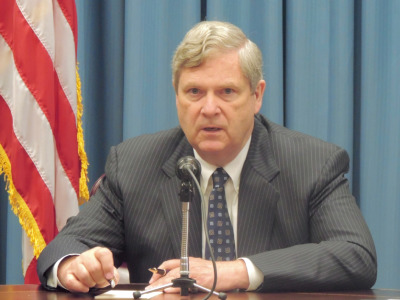While many farmers and ranchers have been successful in reducing their carbon footprint, making significant new progress in reducing greenhouse gas emissions will require government assistance and new financial incentives, especially now that farmers are struggling to cope with depressed commodity prices, senators were told Tuesday.
Government regulations also could stymie the development of new technologies, according to testimony at a Senate Agriculture Committee hearing.
“The reality is that agriculture can be leaders in solving this pollution crisis,” said the committee’s ranking Democrat, Debbie Stabenow, D-Mich. “This is about opportunity.”
The hearing represented a marked departure from recent congressional history on the climate issue in that the committee is controlled by Republicans. There appeared to be bipartisan support for reducing agricultural greenhouse gas emissions, at least on a voluntary basis.
But Nebraska corn and soybean grower Matthew Rezac, who recently won a sustainability award from Land O’Lakes, warned that on their own, farmers can’t afford the cost of making further improvements to conservation practices in the existing farm economy.
“This is what’s right for the country. This is what’s right for the ground and moving forward and for conservation and everything else. But it just doesn’t matter. If you don’t have the money to spend you can’t keep moving forward,” said Rezac.
That prompted committee member Mike Braun, R-Ind., to say that industry needed to help farmers with the cost of conservation improvements. “Along with doing some things through government, it’s going to be a joint challenge to get through this tough stretch.”
Former Agriculture Secretary Tom Vilsack, who is now president and CEO of the U.S. Dairy Export Council, called for USDA to set up a series of pilot projects to measure and quantify the reductions in greenhouse gas emissions that various practices and technology can produce.
"We have to show people what is possible,” Vilsack told the committee.

Tom Vilsack, USDEC
He also urged lawmakers to protect conservation programs from cuts and to increase spending on agricultural research.
“You cannot ask farmers to do this on their own. They simply do not have the resources. They have the will but not the resources,” he said.
Echoing a concern expressed by Senate Agriculture Chairman Pat Roberts, R-Kan., at the outset of the hearing, Vilsack also said it’s critical for the government to streamline the regulations to get improved feed additives and seed genetics to the market. He cited his own effort as secretary to accelerate the regulatory process for new biotech crop traits. Feed additives under development for dairy cattle could reduce the amount of methane, a potent greenhouse gas, that they emit.
Delays in the regulatory approvals can put U.S. farmers “at a competitive disadvantage in the global market,” he said.
Frank Mitloehner, an animal scientist at the University of California, Davis, who specializes in studying the climate impact of agriculture, said state regulations could have the unintended effect of increasing emissions.

Frank Mitloehner, UC Davis
He said California’s drive to reduce emissions from the livestock industry by 40 percent is leading some dairy producers to consider leaving for other states. The irony, he said, is that the farms’ emissions will be higher in other states than if they had stayed in California. The operations would no longer be subject to California regulations and could also expand.
“We’ll not reduce the emissions with this kind of regulatory pressure but we’ll increase them,” he said.
Rezac said farm bill programs such as the Conservation Stewardship Program provide critical assistance to producers, but he expressed concern that the Natural Resources Conservation Service is short-staffed at the field level. Many producers don’t know the assistance exists, he said.
“To be quite honest, a lot of people have a hard time even finding these programs. They don’t know that they’re out there unless they really look for them and dig into them,” Rezac said.
Rezac uses precision agriculture techniques on his farm, including variable rate fertilizer applications, soil moisture probes to guide irrigation timing, and plant tissue sampling to monitor nutrient needs.
He’s also identified areas with poor soils where it doesn’t make sense to continue planting crops; at least one of those he turned into butterfly habitat, which can qualify for federal assistance. “That’s really out there for a farmer, but it pays really well,” he told the senators.
Roberts emphasized that farmers were already doing a lot on their own to reduce their carbon footprint, but he said that the efforts have “been self-initiated and largely self-funded” and relied on improvements in farming practices and technology.
Mitloehner said the improved efficiency of U.S. livestock production means American farmers and ranchers produce meat and dairy products with fewer emissions than many other countries. A single U.S. cow produces about 23,000 pounds of milk a year, while it takes up to five cows in Mexico and 20 in India to produce that much.
The U.S. beef industry produces 24 million tons of meat a year with 90 million head of cattle. In 1970 it took 140 million head to produce that much beef.
For more news, go to www.Agri-Pulse.com.


